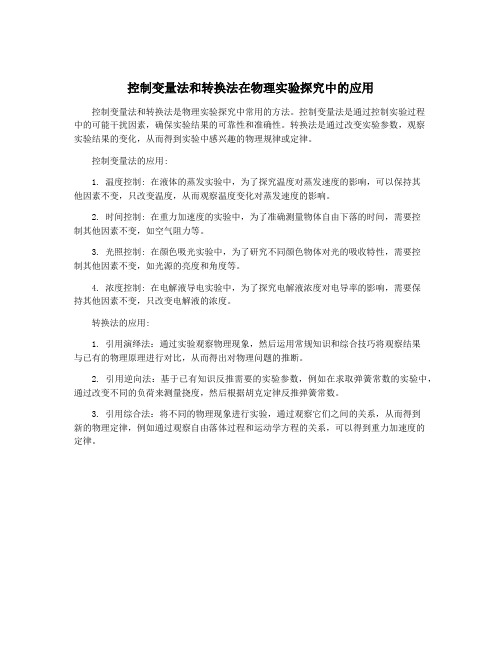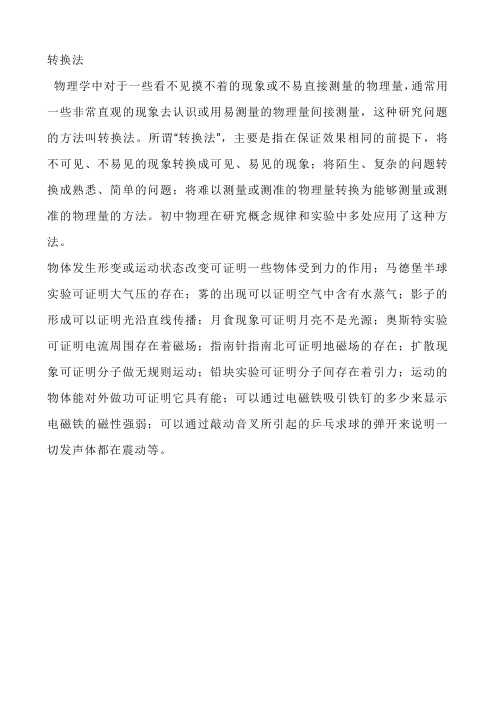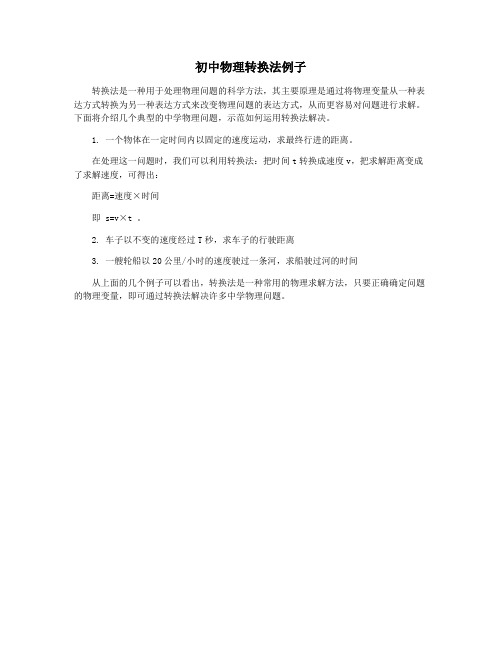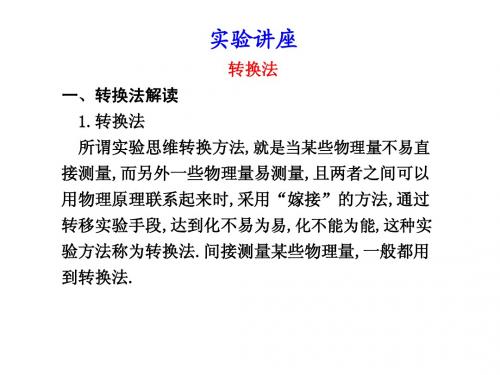转换法
控制变量法和转换法在物理实验探究中的应用

控制变量法和转换法在物理实验探究中的应用
控制变量法和转换法是物理实验探究中常用的方法。
控制变量法是通过控制实验过程
中的可能干扰因素,确保实验结果的可靠性和准确性。
转换法是通过改变实验参数,观察
实验结果的变化,从而得到实验中感兴趣的物理规律或定律。
控制变量法的应用:
1. 温度控制: 在液体的蒸发实验中,为了探究温度对蒸发速度的影响,可以保持其
他因素不变,只改变温度,从而观察温度变化对蒸发速度的影响。
2. 时间控制: 在重力加速度的实验中,为了准确测量物体自由下落的时间,需要控
制其他因素不变,如空气阻力等。
3. 光照控制: 在颜色吸光实验中,为了研究不同颜色物体对光的吸收特性,需要控
制其他因素不变,如光源的亮度和角度等。
4. 浓度控制: 在电解液导电实验中,为了探究电解液浓度对电导率的影响,需要保
持其他因素不变,只改变电解液的浓度。
转换法的应用:
1. 引用演绎法:通过实验观察物理现象,然后运用常规知识和综合技巧将观察结果
与已有的物理原理进行对比,从而得出对物理问题的推断。
2. 引用逆向法:基于已有知识反推需要的实验参数,例如在求取弹簧常数的实验中,通过改变不同的负荷来测量挠度,然后根据胡克定律反推弹簧常数。
3. 引用综合法:将不同的物理现象进行实验,通过观察它们之间的关系,从而得到
新的物理定律,例如通过观察自由落体过程和运动学方程的关系,可以得到重力加速度的
定律。
物理研究方法3转换法课件北师大版物理八年级上册

。
(2)方法:
。
123
3. [2024·秦皇岛期中]某同学想测量一元硬币的周长,请你帮 忙设计测量方案。
(1)工具:一元硬币、 刻度尺 。
(2)方法: 将一元硬币用记号笔做一个记号,在白纸上 画一条直线,让硬币从记号开始沿白纸上的直线笔直 滚一周,记录起点和终点,用刻度尺测出两点之间的 长度L,就是该枚硬币的周长 。
北师版 八年级上
物理研究方法
物理研究方法3 转换法
1. 转换法:在物理学中对一些不易观察的物理现象或不易直 接测量的物理量,通常用一些较直观、易观察的现象去认 识,或用易测量的物理量间接测量,这种研究问题的方法 叫转换法。
2. 运用转换法的实验或仪器的总结
1. [2024·保山期末]把一块石头扔进水里,可以看到一圈圈的 波纹向四周散去,水面上的树叶也随之起伏。我们说,扔
123
123
(1)测量步骤:
。
(2)表达式S=
。
123
(1)测量步骤:
张质量、厚度均匀的硬纸板上;剪下画在硬纸板上的
“地图”,用电子秤称出它的质量m图;在相同硬纸板
上再剪一个形状规则、面积为S样的样品,称出其质量
m样 。
(2)表达式S=
。
123
3. [2024·秦皇岛期中]某同学想测量一元硬币的周长,请你帮
石头的能量通过水波传给了树叶。声波也是一种波,那么
声波能传递能量吗?现提供以下实验器材:扬声器、蜡
烛、火柴。为了证明声波能传递能量,应进行的操作
是 ;若观察到
物理实验讲座之转换法

(2)若小球平衡时,电压表读数为U,用m、l、h、
E、U表示水的作用力F,F= .(重力加速度为g)
解析
(1)电路图如下图所示
F (2)由平衡条件得 =tan ,而tan = CD mg h F U 根据串联电路分压原理,有 l CD 联立上述三式得水流作用力F= mglU ,因F∝U Eh 故从电压表读数的大小便知水流作用力的大小.
解析 (1)由变阻器可组成调压电路,其中调节范围大 的是由电源与滑动变阻器组成分压式电路;而电压的
测量只需一只电压表即可.电路如下图所示.
(2)测量步骤与结果如下:①调节滑动变阻器,使
力电转换器的输出电压为零;②将已知质量的砝码 m0放在力电转换器上,记下输出电压U0;③将待测物
放在力电转换器上,记下输出电压U. U0 m0U 由U0=km0g得k= ;又U=kmg,所以m= m0 g U0 (3)①待测物体质量超出力电转换器量程;②电源
实验讲座
转换法 一、转换法解读
1.转换法
所谓实验思维转换方法,就是当某些物理量不易直 接测量,而另外一些物理量易测量,且两者之间可以 用物理原理联系起来时,采用“嫁接”的方法,通过 转移实验手段,达到化不易为易,化不能为能,这种实 验方法称为转换法.间接测量某些物理量,一般都用 到转换法.
2.转换法的主要方式有
电压不够而输出电压一开始调不到零. 答案 见解析
返回
答案 (1)见解析图 (2)
mglU Eh
【例2】某同学为了测量一物体的质量,找到一个
Hale Waihona Puke 力电转换器,该转换器的输出电压正比于受压面的压
力(比例系数为k),如图2中的装置所示,测量时先调 节输入电压,使转换器空载时的输出电压为零,而后 在其受压面上放一个物体,即可测得与物体的质量 成正比的输出电压U.现有下列器材:力电转换器、
构词法(转换法、合成法、派生法)_定义和实例

十、构词法英语主要有三种构词法.即转化法、合成法和派生法。
(一)转化法把一个词从一种词类转化为另一种的方法称作转化法。
1.由名词转化成动词.例如:care n.照顾.当心 ------ v. 关心.担心.照顾cook n.炊事员 ------v. 烹调water n.水------v. 浇水2.由形容词转化成动词.例如:empty adj.空的------v. 使空、变空free adj. 自由的------v. 使自由right adj. 正确的------v. 改正warm adj. 温暖的------v. 热起来;使温暖wet adj. 潮湿的------v. 使潮湿3.由形容词转化成名词.例如:right adj. 正确的------n. 正确.正义.公正wrong adj错误的------n. 错误4.有一些同形异类的双音节词.作动词时重音在后.作名词时重音在前.例如:record v. [ri’k C:d] 记录.录音;record n. [’ r ek C:d] 记录.唱片有个别词.作形容词时重音在前.作动词时重音在后.例如:perfect adj. [’p∂:f ikt] 完美的;perfect v. [p∂’fekt] 使完善5.有些词.因词尾有清辅音和浊辅音的差别而属不同词类。
一般说来.词尾发清辅音的多为名词.发浊辅音的多为动词。
词尾读音不同.拼法也常不一样。
但s和th既可读作清辅音.又可读作浊辅音.因而有时没有拼法的变化。
例如:advice [∂d’v ais] n. ; advise [∂d’v aiz] v.excuse [iks’kju:s] n. ; excuse [iks’kju:z] v.use [ju:s] ; use [ju:z] v.个别词拼法稍有差别.但读音相同.例如:practice n.; practise v.还有一些词在转变为另一词类时.元音和拼法同时发生变化.例如:food [fu:d]食物 n. ; feed[fi:d]喂养.给以食物 v.有些词既可作形容词又可作动词.词形不变而读音不同.例如:live adj. [laiv]活的.活泼的; v. [liv] 活着. 生活(二)合成法两个或两个以上的词结合成一个新词的方法称作合成法。
初中物理控制变量法和转换法

初中物理控制变量法和转换法控制变量法和转换法是物理实验中常用的两种方法。
它们在实验设计和数据分析中起着重要的作用,能够提高实验的准确性和可靠性。
下面将分别对这两种方法进行介绍。
一、初中物理控制变量法控制变量法是指在进行物理实验时,除了研究的变量之外,其他可能影响实验结果的因素都保持不变,以确保实验结果的准确性。
通过控制变量,我们能够更好地分析和理解实验中的关系。
在物理实验中,常常会有多个变量同时影响实验结果。
为了排除其他变量的影响,我们需要控制它们。
例如,在研究重力对物体下落速度的影响时,我们需要保持其他因素不变,如空气阻力、物体质量等。
只有当其他因素不变时,我们才能准确地观察到重力对下落速度的影响。
控制变量法的核心思想是保持其他因素不变,只改变我们研究的变量。
这样,当我们观察到实验结果时,可以更加准确地归因于我们研究的变量。
二、初中物理转换法转换法是一种通过改变实验条件来观察物理现象变化的方法。
通过转换不同的条件,我们可以观察到不同的现象,从而更好地理解物理规律。
转换法常常用于研究物理量之间的关系。
例如,在研究弹簧的弹性系数与伸长长度的关系时,我们可以通过改变弹簧的材料、直径等条件来观察弹簧的变化。
通过转换不同的条件,我们可以得到不同的数据,进而分析物理量之间的关系。
转换法的优势在于可以通过改变实验条件来观察物理现象的变化,从而获得更多的实验数据。
通过分析这些数据,我们可以更好地理解物理规律和现象。
初中物理控制变量法和转换法是两种常用的实验方法。
通过控制变量和转换条件,我们可以更准确地观察和分析物理现象,并推断出物理规律。
这些方法在物理教学和科学研究中都具有重要的价值,帮助我们更好地理解和应用物理知识。
通过学习和实践这些方法,我们能够培养科学思维和实验能力,为未来的学习和研究打下坚实的基础。
转化法和转换法区别初中物理例题

转化法和转换法区别初中物理例题摘要:一、引言1.物理学习中的转化法和转换法2.两者的区别和联系二、转化法1.转化法的定义2.转化法的应用实例3.转化法的优势和局限三、转换法1.转换法的定义2.转换法的应用实例3.转换法的优势和局限四、总结1.转化法和转换法的共同点2.选择使用哪种方法的原则正文:一、引言在初中物理学习中,我们常常会遇到转化法和转换法这两种解题方法。
尽管它们在字面上非常相似,但它们在实际应用中却有着明显的区别。
为了更好地理解和掌握这两种方法,我们有必要对它们进行深入的探讨。
二、转化法转化法,顾名思义,是一种通过将问题转化为另一个更容易解决的问题来求解的方法。
具体来说,它是一种将复杂问题分解为简单问题,然后通过解决简单问题来得出复杂问题答案的方法。
这种方法的优点在于能够降低问题的难度,使我们能够更容易地解决问题。
然而,它的局限性在于,当问题过于复杂时,转化法可能无法找到合适的简单问题来进行转化。
三、转换法转换法与转化法相似,但它更注重的是从不同的角度来观察问题,从而找到问题的解决方法。
这种方法的核心思想是,任何一个问题都有多种可能的解决方法,而转换法就是帮助我们找到最适合的解决方法。
与转化法相比,转换法更加强调创造性和灵活性。
然而,这种方法的局限性在于,它可能需要更多的时间和精力来寻找最佳的解决方法。
四、总结总的来说,转化法和转换法都是帮助我们解决物理问题的有效方法。
它们的不同之处在于,转化法是通过将问题转化为更容易的问题来解决,而转换法是通过从不同的角度来观察问题来找到解决方法。
在实际应用中,我们应该根据问题的具体情况,灵活选择使用哪种方法。
当我们遇到一个复杂的问题时,可以先尝试使用转化法,看是否能够将问题简化。
初中物理中的转换法

初中物理中的转换法
初中物理中的转换法是指在研究物理问题时,通过转换研究对象、物理量或物理状态等,将复杂的物理问题简化为更容易处理的简单问题,从而找出物理量之间的关系,得出物理规律的方法。
转换法是一种非常重要的科学研究方法,它在物理学中应用广泛,能够帮助我们更好地理解和探究物理现象的本质。
转换法可以通过多种方式来实现,比如将不可见的物理量转换为可见的物理量,将抽象的物理模型转换为具体的实物模型,将复杂的物理问题转换为简单的数学问题等。
下面举几个例子来说明转换法的应用:
1.测量不可见或不易测量的物理量时,可以通过转换法将其转换为可见或易测量的物理
量。
例如,在测量声音的响度时,可以将振动的音叉放在水中,通过观察水花的大小来衡量声音的响度;在测量磁场强度时,可以将小磁针放在磁场中,通过观察小磁针的偏转程度来衡量磁场强度。
2.在探究物理规律时,可以通过转换法将抽象的物理模型转换为具体的实物模型。
例如,
在探究电流的热效应时,可以将通电导线绕成线圈放在煤油中,通过观察煤油温度的变化来探究电流的热效应;在探究电磁感应现象时,可以将线圈和电流表串联起来,通过观察电流表的指针偏转程度来探究感应电流的存在。
3.在求解复杂的物理问题时,可以通过转换法将复杂的物理问题转换为简单的数学问题。
例如,在求解液体的压强时,可以将液体的压力转换为对固体的压力进行计算;在求解复杂电路中的电流时,可以通过电流表测量各部分的电流再进行计算。
总之,转换法是一种非常重要的科学研究方法,它能够将复杂的物理问题简化为更容易处理的问题。
在初中物理学习中,掌握转换法能够更好地理解物理概念和规律,提高解题能力和科学素养。
小学数学解题策略(24)——转换法

小学数学解题策略(24)——转换法第二十四讲转换法解答应用题时,通过转换(即转化)题中的情节,分析问题的角度、数据……从而较快找到解题思路,或简化解题过程的解题方法叫做转换法。
(一)转换题中的情节转换题中的情节是运用联想改变原题的某个情节,使题目变得易于解答。
14+6=20(吨)30吨所对应的分率是:答略。
例2 一项工程,甲、乙两队合做要用12天完成。
如果甲队先独做16天,余下的再由乙队独做6天完成。
如果全部工程由甲队独做,要用几天完成?(适于六年级程度)解:求甲队独做要用几天完成全部工程,得先求出甲队的工作效率。
可是题中已知的是甲、乙合做要用的时间,和甲、乙一前一后独做的时间,很难求出甲的工作效率。
如果将“一前一后独做”这一情节变换为“先合做,后独做”就便于解题了。
可这样设想,从甲队的工作量中划出6天的工作量与乙队6天的工作量合并起来,也就是假定两队曾经合做了6天。
情节这样变动后,原题就变换成:一项工程,甲、乙两队合做要用12天完成,这项工程先由甲乙两队合做6天后,余下的工程由甲队单独做10天完成。
如果全部工程由甲队独做要用几天完成?这样就很容易求出甲队的工作效率是:甲队独做完成的时间是:答略。
(二)转换看问题的角度解应用题时,如果看问题的角度不适当就很难解出题。
如果转换看问题的角度,把原来从正面看问题转换为从侧面看或从反面看,把这一数量转换为另一数量进行分析,就可能找到解题思路。
解:一般都沿着女工占总人数的分率去寻找与之相对应的具体人数,但这样往往会误入歧途,难以找到正确答案。
不如根据女工所占分率,换一个角度,想一想男工的情况。
男工人数便占总人数的:后来女工的总人数是:=560-480=80(人)答略。
*例2 求图24-1中阴影部分的面积。
(单位:厘米)(适于六年级程度)解:如果直接计算图中阴影部分的面积,几乎是不可能的。
如果把角度转换为,从大扇形面积减去右面空白处的面积,就容易求出阴影部分的面积了。
转换法在初中物理必做实验中的应用研究

转换法在初中物理必做实验中的应用研究转换法主要是指将原始数据转换成其他形式,以便更好地分析和研究。
在初中物理必做实验中,转换法有着广泛的应用。
一、用转换法研究重力加速度重力加速度是物理中一项重要的物理常数,可以通过转换法来确定。
实验步骤如下:1.将一块小石块用细线固定在天花板上,使其可以摆动。
2.测量石块长度L和摆动周期T,并计算出摆动频率f=1/T。
3.根据公式g=4π^2Lf^2,计算出重力加速度g。
通过这个实验,学生不仅学习了重力原理的基本知识,还锻炼了实验操作和数据处理的能力。
二、用转换法研究光的折射光的折射是光学中的一个重要现象,可以通过转换法来进行研究。
实验步骤如下:1.选取几种不同折射率的透明材料,如玻璃、水等。
2.将一束通过透明材料的光线照射到材料表面上,观察光线的折射现象。
3.测量入射角和折射角,并计算出折射率。
通过这个实验,学生可以深入了解光的传播规律和折射现象,提高实验操作和数据处理的能力。
三、用转换法研究电流的变化规律电流是电学中的重要概念,可以通过转换法来研究电流的变化规律。
实验步骤如下:1.将一个电池与一个电阻连接成电路,测量电路中的电压和电流。
2.改变电阻的数值,观察电压和电流的变化情况。
3.根据欧姆定律,计算出电流与电压的关系。
通过这个实验,学生可以进一步了解电流的变化规律和欧姆定律,提高实验操作和数据处理的能力。
转换法在初中物理必做实验中有着广泛的应用。
通过实验中的转换法,学生不仅可以加深对物理知识的理解,还可以提高实验操作和数据处理的能力。
在物理教学中应重视转换法的应用研究,为学生提供更加丰富的实验体验和学习机会。
初中物理转换法简介

转换法
物理学中对于一些看不见摸不着的现象或不易直接测量的物理量,通常用一些非常直观的现象去认识或用易测量的物理量间接测量,这种研究问题的方法叫转换法。
所谓“转换法”,主要是指在保证效果相同的前提下,将不可见、不易见的现象转换成可见、易见的现象;将陌生、复杂的问题转换成熟悉、简单的问题;将难以测量或测准的物理量转换为能够测量或测准的物理量的方法。
初中物理在研究概念规律和实验中多处应用了这种方法。
物体发生形变或运动状态改变可证明一些物体受到力的作用;马德堡半球实验可证明大气压的存在;雾的出现可以证明空气中含有水蒸气;影子的形成可以证明光沿直线传播;月食现象可证明月亮不是光源;奥斯特实验可证明电流周围存在着磁场;指南针指南北可证明地磁场的存在;扩散现象可证明分子做无规则运动;铅块实验可证明分子间存在着引力;运动的物体能对外做功可证明它具有能;可以通过电磁铁吸引铁钉的多少来显示电磁铁的磁性强弱;可以通过敲动音叉所引起的乒乓求球的弹开来说明一切发声体都在震动等。
物理中的转换法的例子

物理中的转换法的例子
1. 嘿,你知道不,用水流来类比电流,这就是物理中转换法的经典例子呀!比如我们研究电流的大小,就像看水流的快慢一样,多么形象啊!
2. 哇哦,想想看,我们通过小磁针的偏转来知道磁场的存在,这难道不是超厉害的转换法吗?这不就像通过指南针找方向一样明显嘛!
3. 哎呀呀,把难以测量的温度变化转换成液柱的升降,温度计不就是这么干的嘛!这办法可真是巧妙极了!
4. 嘿,你瞧,测压力的时候用压强计,把压力的大小转换成压强的变化来观察,这不就跟寻宝藏找到线索一样令人兴奋嘛!
5. 哇,用弹簧的伸长量来反映力的大小,这转换法简直绝了呀!就好像从蛛丝马迹中发现大秘密!
6. 咦,研究声音在不同介质中传播速度的时候,把它转换成看到的现象,这多有意思呀,就如同从迷雾中逐渐看清真相!
7. 哈哈,把光的传播路径用烟雾显示出来,这不就是把看不见的变看得见嘛,这种转换法可真神奇!
8. 哟,用小球的滚动来理解动能和势能的转化,就像是看着一场精彩的表演一样吸引人呢!
我觉得转换法真的是让物理变得好有趣好易懂啊,它就像一把神奇的钥匙,打开了我们理解物理世界的大门!。
转换法和等效替代法

转换法和等效替代法辨析
孟匠中学崔逢利
一.转换法:
1.将不能测量或不易测量或观察的物体的物理量的转换为可测量或观察的物理量。
2.特点:前后出现的物体往往不同。
3.举例:
(1)在研究光热容是经常用温度计升高的示数(温度变化)来比较吸收热量的多少。
(2)在影响动能大小因素实验种通过较纸盒被推的举例的远近来判断小球具有的动能大小。
(3)在影响摩擦力大小因素实验种通过测量拉力的大小来判断摩擦力的大小。
(4)磁场是看不见、摸不着的,用小磁场中转动方向来确定磁场的方向。
二:等效替代法:
1.定义:将一个不易观察的现象用一个与它实质相同的易观察的量来替代再研究替换后的,得出的结论对替换钱的也适用。
2.特点:前后两个替换的物理量是相同的。
3.举例:
(1)在研究串联电路的尺总时,用尺替代尺1和尺2效果一样。
(2)在研究合力概念时,用F合替代f1合f2两个力效果一样。
(3)在研究平面镜成像特点实验种,用蜡烛B替代虚像的位置,效果是一样的。
总之,学会了这两种科学研究问题的方法,有助于提高学生的科学素养,初步形成科学的世间观和方法论,为终生的学习、发展奠定基础。
转化法和转换法区别初中物理例题

转化法和转换法区别初中物理例题
(原创版)
目录
1.物理中的转换法和转换法区别
2.初中物理中的转换法例题
3.初中物理中的转换法区别例题
正文
物理学中的转换法和转换法区别,主要体现在它们的定义和应用上。
转换法是指在物理问题中,由于有些量不易直接求解,而采用与之相关的其他量来替代或转换的方法。
而转换法则是在物理过程中,由于某些量之间存在特定的关系,从而可以通过一种量来转换另一种量的方法。
在初中物理中,转换法常常被用来解决一些复杂的问题。
例如,当我们需要求解一个物体的动能时,由于直接测量物体的质量和速度往往比较困难,我们就可以采用转换法,通过测量物体的位移和力来计算动能。
另一方面,转换法则常常被用来解决一些涉及到物理量转换的问题。
例如,当我们需要将一个物体的质量从千克转换为克时,我们可以利用转换法则,通过乘以 1000 来实现质量的单位转换。
总的来说,转换法和转换法在物理学中都扮演着重要的角色,它们帮助我们解决了许多实际问题。
第1页共1页。
初二转换法的例子和解释

初二转换法的例子和解释转换法是中学数学中的一个概念,它可以帮助学生将复杂的问题转化为简单的问题,让学生以不同的方法来理解和分析问题。
初二转换法在初二数学中发挥着非常重要的作用。
它是所有初级数学算法的基础,该方法是应用各种运算技巧,以有效地解决复杂问题的一种方法。
下面将介绍初二转换法的一些例子和解释。
第一个例子,我们来看一看这样一个问题:从一个圆形的舞台中心绘制一条直线,使它的长度为6米。
由于圆形舞台的中心点不在x 轴或y轴上,这时候我们可以使用初二转换法来解决此问题。
首先,我们需要将原始问题转换成一个具有特定解的简单问题,即求从原点(即圆形舞台的中心点)出发,绘制一条长度为6米的直线。
这时,我们就可以利用直角三角形的基本定理,给出直线的三角形表达式,从而找出这条直线的斜率和斜边长度。
第二个例子,为了求出某个函数的值,我们需要解决的是这样一个复杂的函数因式分解问题:将一个多项式分成两部分,使其中一部分可以用数学公式表示,另一部分可以用数学表达式求解。
这时,我们可以利用初二转换法将复杂的问题转换成一个简单的问题:利用函数的导数和积分,求函数在某一点处的值。
因此,通过引入函数的导数和积分,我们可以将原来复杂的函数分解问题转换成一个简单而易于求解的问题。
第三个例子,假设我们有一个复杂的函数:f(x) = x^2 + 2x + 1,我们想要求解x的值,但是发现无法直接解出x的值,这时候就可以使用初二转换法。
我们可以使用变量的移项法和公式的交换法,将原来的复杂的函数f(x)变为一个简单的函数g(x):g(x) = x + 1,此时就可以直接求出x的值了。
以上三个例子展示了初二转换法在解决复杂问题时的实际应用,这一方法有助于学生掌握数学中一般和复杂问题的解决方案,培养学生解决问题的能力。
因此,初二转换法的概念和原理是非常重要的,值得学生仔细研究和学习。
物理实验中转换法的例子

物理实验中转换法的例子
嘿,朋友!今天咱就来讲讲物理实验中那些超酷的转换法例子。
你知道压力是个不太好直接测量的东西吧?但咱聪明的科学家们可找到办法啦!就好像要知道一个大力士有多大力气,咱直接测不好测呀,那咋办呢?嘿,他们想到用压强来转化。
利用压强计测量压强,这不就间接知道压力大小了嘛!就好比你要知道一个人唱歌好不好听,你可以通过听众的反应来判断呀!
还有哦,测量电流的时候,那小电流咱也看不见摸不着呀,咋办呢?这时候转换法就出马了!利用电流表,让电流的大小转化成指针的偏转角度,哇塞,一下子就直观多啦!这就好像你想知道一个人心情好不好,通过他脸上的笑容不就能猜个大概嘛。
再说说测量微小的长度变化。
哎呀,那么小的变化,眼睛都快看花了也看不清呀!但是呢,科学家们想出了用光杠杆来放大这个微小变化。
就像你要找掉在草丛里的一根针,自己找半天找不到,但是用个放大镜一下子就看到啦!
咱物理实验中的转换法,那可真是像孙悟空一样神通广大呀!它能把那些难以测量的物理量变得可以测量,可以理解。
这多有趣,多神奇呀!没有转换法,很多物理知识可能就没法弄清楚啦。
它就像是一把神奇的钥匙,打开了物理世界里一扇又一扇神秘的门。
所以说呀,转换法在物理实验中真的是超级重要,超级厉害的!它让我们能更好地理解和探索这个奇妙的物理世界!。
初中物理转换法例子

初中物理转换法例子
转换法是一种用于处理物理问题的科学方法,其主要原理是通过将物理变量从一种表达方式转换为另一种表达方式来改变物理问题的表达方式,从而更容易对问题进行求解。
下面将介绍几个典型的中学物理问题,示范如何运用转换法解决。
1. 一个物体在一定时间内以固定的速度运动,求最终行进的距离。
在处理这一问题时,我们可以利用转换法:把时间t转换成速度v,把求解距离变成了求解速度,可得出:
距离=速度×时间
即s=v×t 。
2. 车子以不变的速度经过T秒,求车子的行驶距离
3. 一艘轮船以20公里/小时的速度驶过一条河,求船驶过河的时间
从上面的几个例子可以看出,转换法是一种常用的物理求解方法,只要正确确定问题的物理变量,即可通过转换法解决许多中学物理问题。
转换法

解析 (1)电路图如下图所示
(2)由平衡条件得
F mg
=tan ,而tan
=
根据串联电路分压原理,有 F U
CD h
l CD
联立上述三式得水流作用力F= mglU ,因F∝U
Eh
故从电压表读数的大小便知水流作用力的大小.
答案 (1)见解析图 (2) mglU Eh
【例2】某同学为了测量一物体的质量,找到一个 力电转换器,该转换器的输出电压正比于受压面的压 力(比例系数为k),如图2中的装置所示,测量时先调 节输入电压,使转换器空载时的输出电压为零,而后 在其受压面上放一个物体,即可测得与物体的质量 成正比的输出电压U.现有下列器材:力电转换器、 质量为m0的砝码、电压表、滑动变阻器、干电池各 一个、开关及导线若干、待测物体(可置于力电转 换器的受压面上).请完成对该物体质量的测量.
二、转换法的应用 1.匀变速直线运动的加速度,是一个不易直接测
量的物理量,但通过转换测位移和时间,根据任意两 个连续相等的时间里的位移之差可测得加速度.
2.在“传感器的简单应用”实验中,将非电学量转 换为电学量进行测量.
【例1】用如图1所示的装置可测水的作用力,质量
为m的小铅球P系在细金属丝下,悬挂在O点,BC为在 水平方向固定的一根粗细均匀的电阻丝,C端在O点 正下方,且OC=h,BC长为l,BC与金属丝接触良好,接 触点为D,不计接触点D处的摩擦和金属丝的电阻.将 小铅球P放入水平流动的水中时,球向左摆起一定的
角度 时,水流速度越大, 越大.现取一电动势为
E、内阻不计的电源和一只电压表,用这些器材连成 测量电路,使水不流动时,电压表示数为零,水流速度
增大时,电压表示数增大.
图1
转换法

物理学术语
01 简介
03 应用
目录
02 分类 04 实例
转换法是指在创造发明活动中,针对某个对象的探索遇到障碍、挫折而受阻时,或得到的解决问题方案并不 理想时,于是改变观察思考问题的角度,改变运用的方法或实施的手段,改变解决问题的途径,或者改变事物内 部的结构,从而使问题明确化,求得比较满意结果的一种思维方法。
应用
测量仪器:秒表、电流表、电压表、电阻表、弹簧测力计、气压计、微小压强计、温度计、托盘天平、电能 表、测电笔……
物理实验:探究声音产生的原因、探究液体压强的特点、探究影响导体产生电热多少的因素、探究压力的作 用效果、电磁铁的磁性强弱……
用转换法(卡测法)测量硬币、乒乓球直径、圆锥体高度;
实例
感谢观看
Байду номын сангаас
物体发生形变或运动状态改变可证明一些物体受到力的作用;马德堡半球实验可证明大气压的存在;雾的出 现可以证明空气中含有水蒸气;影子的形成可以证明光沿直线传播;月食现象可证明月亮不是光源;奥斯特实验 可证明电流周围存在着磁场;指南针指南北可证明地磁场的存在;铅块实验可证明分子间存在着引力;运动的物 体能对外做功可证明它具有能;可以通过电磁铁吸引铁钉的多少来显示电磁铁的磁性强弱;可以通过敲动音叉所 引起的乒乓球的弹开来说明一切发声体都在振动等。
转换测量方法大致可分为参量转换法和能量转换法。
分类
一、参量转换法
参量转换法利用各物理量之间的变换关系来测量某一物理量,这一方法几乎贯穿于整个物理实验领域。例如 在用拉伸法测金属弹性模量实验中,要测量的是弹性模量E,而实际测量的是应力和应变,变换关系是由胡克定律 得到的,即
二、能量转换法
能量转换法利用换能器(如传感器)将一种形式的能量转换为另一种形式的能量,从而通过测量另一种物理 量来获得待测的物理量。由于电学量测量方便,通常将非电量转换为电学量测量,常见的能量转换有热电转换、 压电转换、光电转换和磁电转换。
转换法

【例1】用如图1所示的装置可测水的作用力,质量 用如图1所示的装置可测水的作用力, 为m的小铅球P系在细金属丝下,悬挂在O点,BC为在 的小铅球P系在细金属丝下,悬挂在O BC为在 水平方向固定的一根粗细均匀的电阻丝, 端在O 水平方向固定的一根粗细均匀的电阻丝,C端在O点 正下方, OC= BC长为l BC与金属丝接触良好, 正下方,且OC=h,BC长为l,BC与金属丝接触良好,接 长为 与金属丝接触良好 触点为D 不计接触点D处的摩擦和金属丝的电阻. 触点为D,不计接触点D处的摩擦和金属丝的电阻.将 小铅球P放入水平流动的水中时, 小铅球P放入水平流动的水中时,球向左摆起一定的 水流速度越大, 越大. 角度 θ 时,水流速度越大, θ 越大.现取一电动势为 E,内阻不计的电源和一只电压表,用这些器材连成 内阻不计的电源和一只电压表, 测量电路,使水不流动时, 压表示数为零, 测量电路,使水不流动时,电压表示数为零,水流速度 增大时,电压表示数增大. 增大时,电压表示数增大.
2.转换法的主要方式有 2.转换法的主要方式有 (1)时间量与空间量的转换, (1)时间量与空间量的转换,如伽利略在研究自由 时间量与空间量的转换 落体运动时,利用滴漏法来测时间, 落体运动时,利用滴漏法来测时间,将时间测量转换 为水的体积的测量. 为水的体积的测量. (2)抽象量与直观量的转换,如卡文迪许" (2)抽象量与直观量的转换,如卡文迪许"扭秤实 抽象量与直观量的转换 验"中,石英丝扭转角度的测量转换为平面镜反射光 在刻度尺上移动距离的测量. 在刻度尺上移动距离的测量. (3)微观量与宏观量的转换. (3)微观量与宏观量的转换. 微观量与宏观量的转换 (4)非电学量与电学量的转换. (4)非电学量与电学量的转换. 非电学量与电学量的转换
- 1、下载文档前请自行甄别文档内容的完整性,平台不提供额外的编辑、内容补充、找答案等附加服务。
- 2、"仅部分预览"的文档,不可在线预览部分如存在完整性等问题,可反馈申请退款(可完整预览的文档不适用该条件!)。
- 3、如文档侵犯您的权益,请联系客服反馈,我们会尽快为您处理(人工客服工作时间:9:00-18:30)。
第八讲:翻译技巧(上)——词类转换法[<]
7. 他慢条斯理地点了一两下头说:“是的。” 慢条斯理地点了一两下头说:“是的。” “Yes,” he said with a slow nod or two. 8. 他们热忱地欢迎他。 他们热忱地 热忱地欢迎他。 They give him a hearty welcome. 9. 他会立即答复。 他会立即 立即答复。 He will give an immediate reply.
第八讲:翻译技巧(上)——词类转换法[<]
3. Stevenson was eloquent and elegant—but soft. elegant— 史蒂文森有口才 史蒂文森有口才、有风度,但很软弱。 口才、有风度 风度,但很软弱。
no less than… “同 … 一样”,“不亚于”
4. This problem is no less important than that one. 这个问题的重要性 这个问题的重要性不亚于那个问题。 重要性不亚于那个问题。 5. Glass is more transparent than plastic cloth. 玻璃的透明度 玻璃的透明度比塑料布要好。 透明度比塑料布要好。
第八讲:翻译技巧(上)——词类转换法[<]
C. 前置词转换为动词
8. “Coming!” Away she skimmed over the lawn, up the path, up the steps, across the veranda, and into the porch. “来啊!” 她转身蹦着跳着地跑了, 越过 越过草地, 跑上 跑上小径, 跨上台阶, 穿过 穿过凉台,进了 进了门廊。 跨上 进了 9. Jones opened the windows to let fresh air in. 琼斯把窗子打开,让新鲜空气进来 进来. 进来 10. That day she was up before sunrise. 那天她在日出前就起来了 起来了. 起来了
第八讲:翻译技巧(上)——词类转换法[<]
B. Adjectives—Adverbs Adjectives— 3. He had a careful study of the map before he started off. 他在出发前仔细地看了看地图。 4. Can you give an accurate translation of the sentence? 你能准确地把这句话译出来吗? 很简单,由于英语中带有动作意味的名词汉译为动词, 因而原文修饰名词的形容词也业相应地汉译为副词,以 便修饰动词。
第八讲:翻译技巧(上)——词类转换法[<]
B. Adverbs—Adjectives Adverbs—
4. The English language has changed subtly and pervasively. 英语的变化很敏感,很普遍。 5. She looked at me expectantly. 她用期待的 她用期待的眼光看着我。 期待的眼光看着我。 6. Hopefully, it will be done early next month. 下月初完成这项工作是大有希望的 下月初完成这项工作是大有希望的。 大有希望的。
第八讲:翻译技巧(上)——词类转换法[<]
2. 转译成名词
A. Verbs-Nouns 英语中有许多由名词派生的动词,以及由名词转用的 动词,在汉语中往往不易找到相应的动词,这时可将 其转译成汉语的名词。如: 1. She behaves as if she were a child. 她的举止 举止跟一个孩子一样。 举止 2. A well-dressed man, who looked and talked like an American, got into the car. 一个衣着讲究的人上了车,他的言谈举止 言谈举止酷似美国人。 言谈举止
3. The new type of machine is shown schematically in Figure 1. 图一所示是这种新型机器的简图。 图一所示是这种新型机器的简图。
第八讲:翻译技巧(上)——词类转换法[<]
3. 转译成形容词
A. Nouns—Adjectives
1. I can note the grace of her gesture. 我可以看到她优雅的 优雅的举止。 优雅的 2. We have seen the beauty of Mt. Tai. 我们看到了美丽的 美丽的泰山。 美丽的 3. Independent thinking is an absolute necessity in study. 独立思考是学习所绝对必要的。 必要的。 必要的
第八讲:翻译技巧(上)——词类转换法[<]
B. 英语中加后缀-er, -or 的名词,在句中并不表身 英语中加后缀的名词, 份和职业,而是含有较强的动作意义。 份和职业,而是含有较强的动作意义。 5. He is no smoker, but his father is a chain-smoker. smoker, chain他倒是不抽烟 他倒是不抽烟,但他的爸爸却一支接一支地抽(是个 抽烟,但他的爸爸却一支接一支地抽(是个 老烟枪)。 6. He was a regular visitor. 他经常来。 来 7. What kind of sailor are you? (a bad sailor or a good sailor?) 你晕不晕船? 晕不晕船?
第八讲:翻译技巧(上)——词类转换法[<]
A. 由动词的派生词名词(或含有动作意义的 由动词的派生词名词( 名词) 名词)转译为动词
2. His very appearance at any affair proclaims it a triumph. 无论什么事情,只要他一露面 无论什么事情,只要他一露面,就算是成功了。 露面,就算是成功了。 3. An acquaintance of world history is helpful to the study of translation. 读一点世界史,对学习翻译是有帮助的。 4. A view of Mt. E-mei can be obtained from here. E从这儿可以看到 从这儿可以看到峨嵋山。 看到峨嵋山。
第八讲:翻译技巧(上)——词类转换法[<]
教学要求
本讲通过大量的讨论、讲解,旨在帮助学生 了解并熟悉词类转换法(Conversion)的翻译 技巧;在此基础上了解英汉语常见的差异。
教学内容
转译为动词 转译为名词 转换句子成分
转译为形容词 转译为副词
第八讲:翻译技巧(上)——词类转换法
[<]
In terms of conversion we mean that in translation a word in one language belonging to a certain part of speech is not necessary to be turned into one of the same part of speech in another language. As a matter of fact, conversion in the English language is very common. Let’s take the word “round” for example: a)This is the first round. b)There is a round table in the room. c)Round the corner slowly. d)He walked round the table.
第八讲:翻译技巧(上)——词类转换法[<]
C. 表语转作主语 1. Matter is anything that occupies space. 凡占用空间的都是物质。 2. The rotor is a well-designed structure. 转子的结构设计的很好。 3. Rubber is a better dielectric but a poorer insulator than air. 橡胶的介电性比空气好,但绝缘性比空气差。
汉译英中副词转为形容词,常常是与动 词转译为名词关联着的。动词转译为名 词,这原文中修饰动词的副词也自然地 要转译为形容词,以修饰名词。例如第 7、8、 9、等。
第八讲:翻译技巧(上)——词类转换法[<]
4. 转译成副词
A. Nouns—Adverbs Nouns—
1. The man nodded with satisfaction. 那人满意地 那人满意地点了点头。 满意地点了点头。 2. He had the honor to attend the congress. 他荣幸地出席了代表大会。 荣幸地出席了代表大会。
第八讲:翻译技巧(上)——词类转换法[<]
二、 转换句子成分
A. 宾语转换作主语 1. The earth has the shape of a spheroid. 地球的形状是椭圆形的。 2. The road has an ascent of five degree. 这条路的坡度为五度。 3. The engine has given a consistently performance. 这台发动机的性能一直很好。
第八讲:翻译技巧(上 He is strong of will. 他的意志很坚强。 2. With the introduction of the new method, the products decreased in cost. 引进了新方法,产品的成本降低了。 3. It is obvious that various substances differ widely in their magnetic characteristics. 显然,各种材料的磁特性有很大的不同。
